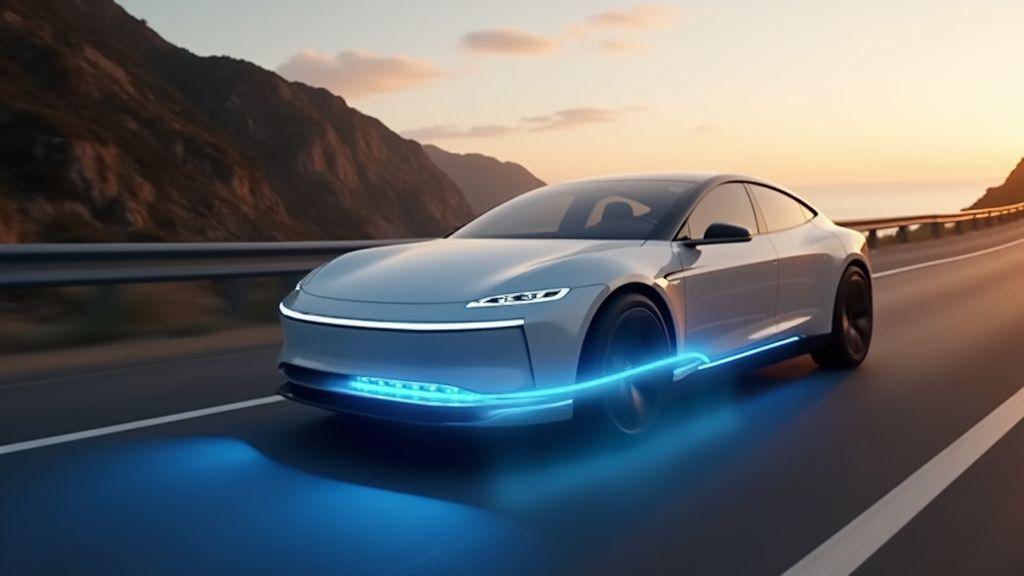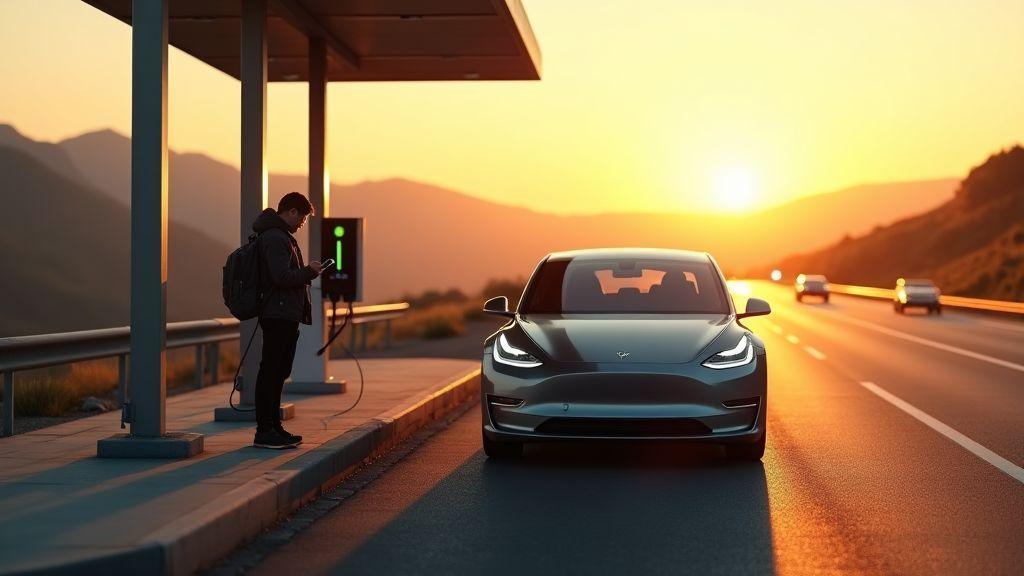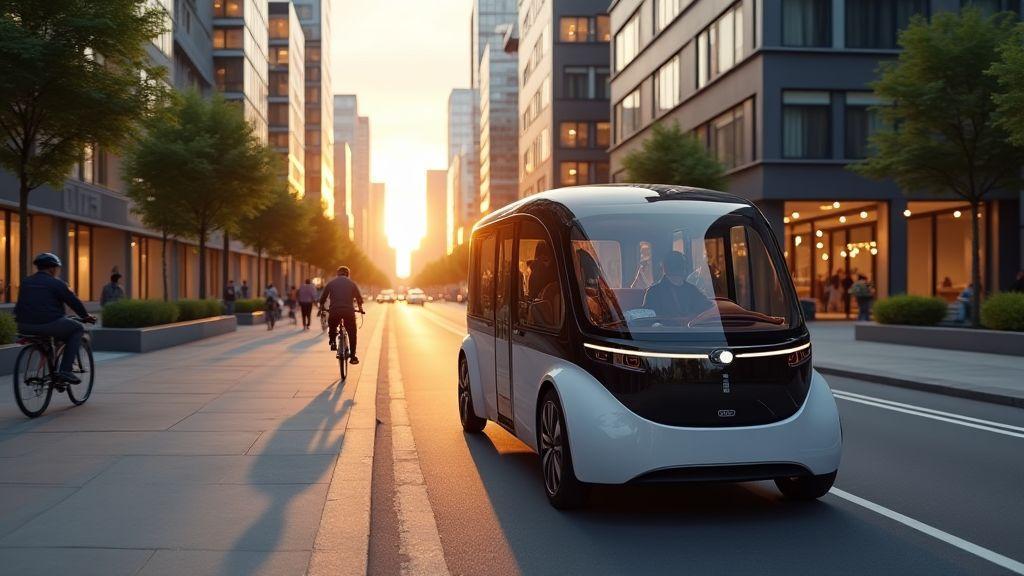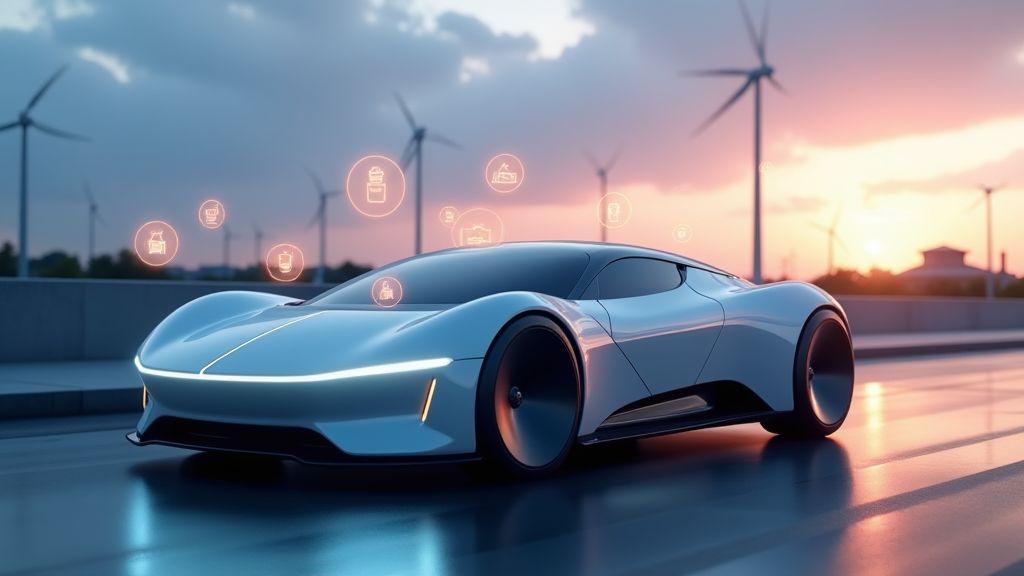The Future of Electric Cars: Seven Innovations Coming Soon
The Future of Electric Cars: 7 Innovations Coming Soon is your quick guide to what’s next for your EV. It shows how solid state batteries boost your range and cut fire risk, explains wireless charging for easy daily top-ups, breaks down fast charging for long trips, maps vehicle-to-grid power and how your car can support your home, covers autonomous EVs, safety gains and energy savings, and looks at lightweight materials and AI energy management that stretch every mile.
Key Takeaway
- Your car will go much farther between charges.
- You will charge faster at improved charging stations.
- You can charge without cables using wireless systems.
- Your battery will cost less, be safer, and last longer.
- Your car will connect with your home and the grid to save energy.

How solid state batteries will improve your range and safety in The Future of Electric Cars: 7 Innovations Coming Soon
Solid state batteries give your EV more miles for the same weight. By swapping the liquid electrolyte for a solid one and often using a lithium-metal anode, cells can store more energy per kilogram. That means your car can go farther between charges without needing a much bigger pack. For a technical summary, see the Overview of solid-state battery technology.
Safety improves dramatically. The liquid electrolyte in today’s cells is flammable and can feed thermal runaway. A solid electrolyte cuts that risk, tolerates heat spikes better, and is less likely to ignite after a crash or failure. You get a pack that stays cooler and calmer under stress.
You’ll also see longer battery life and faster charging in many test cars. Solid materials resist the microscopic damage that kills capacity over time, and labs report better retention after many cycles. Faster charging is possible because the chemistry handles lithium plating and heat stress differently. Put simply: more range, fewer fires, and batteries that age more slowly.
Why solid state cells offer higher energy density and lower fire risk
Solid electrolytes (ceramics, glass, or polymers) move ions but don’t burn. That opens the door to lithium-metal anodes, which hold far more charge by weight than graphite. With more active material in the same space, you get higher energy density—longer range without a heavier car.
Solid electrolytes aren’t flammable and they slow or block dendrite growth—tiny metal filaments that can pierce separators and short cells. With fewer pathways to shorts and no flammable liquid to feed a fire, thermal runaway is much harder to start.
Which automakers and suppliers are testing solid state technology now
Major automakers and startups are racing to put solid state into cars. Toyota, Volkswagen, Ford, Hyundai, Honda and several European brands are funding research and running pilots. Startups and suppliers like QuantumScape, Solid Power, Samsung SDI, and CATL are active in labs and demo vehicles. Expect more demo cars and production pilots in the next few years as companies move from benches to factory floors.
Measured gains in charge cycles and energy density
Lab and prototype results show solid-state cells can lift energy density and cycle life by large margins versus today’s mainstream lithium‑ion cells. Improvements vary, but tests routinely report higher Wh/kg and better retention after many cycles.
| Metric | Typical Li‑ion (today) | Prototype solid‑state (lab/pilot) | Typical improvement |
|---|---|---|---|
| Energy density (Wh/kg) | 200–260 | 350–500 | ~40–150% higher |
| Cycle life (useful cycles) | 800–2,000 | 2,000–5,000 | ~2–3× longer |
| Fire risk | Moderate (flammable liquid) | Low (solid electrolyte) | Substantially reduced |
How wireless EV charging can simplify your daily charging
Wireless charging can turn a daily chore into a small luxury. You pull into your space, park, and the car starts charging without cords—no fumbling with plugs in rain, snow, or low light.
Wireless pads also let you automate charging around time-of-use rates and grid signals. Your car can accept a scheduled top-up while you sleep. Headlines such as The Future of Electric Cars: 7 Innovations Coming Soon list wireless charging as a habit-changing tech; it truly changes how you plan trips and routines.
Integration with homes, workplaces, and fleets saves steps for owners and staff. For fleets, faster parking turnover matters. For home use, you avoid cable storage and wear. As more public lots add pads, you’ll notice fewer damaged cords and interrupted charges.
Parking pad systems and on-road charging trials explained
Parking pad systems use coils in a pad under your driveway or parking spot and a matching coil under the car. When aligned, an alternating magnetic field moves energy across the gap. The process is automatic and can pair with smartphone apps showing charge status. Installation varies in cost but is straightforward for most residential sites.
On-road or dynamic charging puts coils under lanes and charges vehicles as they drive. Trials are active in Europe and Asia for buses and trucks, using road segments that energize only when a vehicle is present. These projects look promising for reducing battery size on long-haul vehicles but will take years and major public investment to scale.
Key points to weigh:
- Convenience — park and forget.
- Alignment — small errors can cut efficiency.
- Cost — pads add upfront expense.
- Infrastructure scale — on-road charging needs big public investment.
Efficiency losses, real charging speeds, and what to expect
Wireless charging is typically a bit less efficient than plugging in. Expect around 85–95% efficiency for static pads at short gaps. That means a small extra draw from the grid and slightly longer charge times—important on long drives but rarely a deal-breaker for overnight home top-ups.
Real-world charging speeds depend on the pad and car. Home pads often deliver 3.7–11 kW today. Commercial pads and newer systems can reach 20 kW or more. Dynamic systems aim higher, but practical speeds depend on vehicle design and road power. Heat, coil gap, and alignment are the main factors that reduce speed and raise losses.
| System type | Typical power (kW) | Typical efficiency | Best use |
|---|---|---|---|
| Home parking pad | 3.7–11 | 85–92% | Overnight top-ups |
| Commercial pad | 7–20 | 88–93% | Short parking stays |
| Dynamic on-road | 20 | 80–90% | Buses, trucks, transit lanes |
Standards, safety limits, and rollout facts
Standards like SAE J2954 guide alignment, power levels, and testing. Safety rules limit electromagnetic fields and require systems to shut off when people or metal objects intrude. Rollout will be gradual: expect more home and fleet installs first, then targeted public deployments. Interoperability and permit hurdles mean steady growth over years, not an overnight swap.

What fast charging infrastructure means for your long trips
Fast charging turns a long drive from a leap of faith into a series of planned stops. With good fast chargers along your route, you can treat charging like refueling: predictable pauses, not uncertain delays. The biggest win is flexibility: plan routes where chargers sit at logical points—highway exits, rest areas, or shopping centers—so charging time becomes useful time. The U.S. DOE offers a useful Guide to EV charging infrastructure and standards.
But it’s not magic. Charger availability, connector type, and your car’s acceptance rate decide how fast you actually get moving. The charging network and vehicle tech are improving fast—The Future of Electric Cars: 7 Innovations Coming Soon highlights that—but smart planning still makes trips smooth.
Charger power levels from 50 kW up to 350 kW and how they affect time
Charger power is simple to read but complex in practice. A 50 kW charger will get you moving, but it’s slower. A 150–250 kW charger cuts a stop to a quick coffee. A 350 kW unit can be almost pit-stop fast—if your car and battery can take it. Real-world time depends on battery size, current state-of-charge, and pack temperature.
Approximate 10–80% charge times for a 75 kWh battery:
| Charger power (kW) | Typical 10–80% time (75 kWh) |
|---|---|
| 50 kW | 70–90 minutes |
| 150 kW | 25–40 minutes |
| 250 kW | 15–25 minutes |
| 350 kW | 10–20 minutes |
Network growth, station locations, and connector standards like CCS and NACS
Networks are filling in along main roads first, then towns and shopping hubs. You’ll see chargers at highway rest stops, malls, hotels, and workplaces—corridors for long drives and destination chargers for arrivals.
Connector standards shape which stations you can use. CCS is common across many brands and regions. NACS (Tesla’s connector) is growing fast and getting adapters or native support. Checklist:
- Pick corridors with chargers that match your car.
- Favor stations with multiple high-power units.
- Check apps for live availability.
- Carry adapters if your car needs them.
Average charge times and battery heat management
Batteries charge fastest in their mid-range and when at optimal temperature. Cold packs slow charging and heat buildup forces tapering. Your car may precondition the battery if you set navigation to a fast charger. On long trips, pre-warming before arrival and planning shorter, more frequent stops often beats one long top-up.
How vehicle-to-grid technology and bidirectional charging let your car support the grid
Vehicle-to-grid (V2G) and bidirectional charging let your car act like a small power plant. When you plug in, power can flow both ways. Your battery stores energy when prices are low and sends it back when the grid needs help—lowering bills and helping during short outages. The National Renewable Energy Laboratory provides a detailed Research overview of vehicle-grid integration.
You can offer services such as peak shaving, frequency regulation, and local backup. Peak shaving cuts demand during busy hours and reduces grid strain. Frequency regulation smooths imbalances between supply and demand. For owners, that can mean credits on your bill or payments if your utility or an aggregator enrolls your car.
Getting started takes the right charger, software, and agreements—you should also review privacy considerations around data sharing and consent. Chargers must support bidirectional power and talk to your car’s battery management system. Utilities or aggregators need to communicate with your charger for timing and compensation; if you need local options or installers, consider reaching out through our contact page.
Basics of V2G: how your car can send power back to homes and the grid
Power flows from your car through the onboard or external bidirectional inverter. The system checks state of charge, temperature, and safety limits before sending power. Protocols such as ISO 15118 and legacy standards let the car and charger agree on rates and permissions.
Your battery management system keeps cycles safe. When you set limits in the app, the software follows them—you choose when to reserve charge for driving and when to allow exports.
Pilot projects, utility rules, and payment models you should know
Pilots in Japan, Europe, and North America show V2G works at scale. Utilities test fleets of cars to provide grid services. Results often show small payments per kW offered and larger savings when cars reduce peak demand.
Common payment models:
- Time-of-use credits for energy sent during peak hours.
- Capacity payments for reserving power availability.
- Energy buyback at a set rate per kWh delivered.
- Aggregator fees where a service pools many cars and shares revenue.
Utilities set interconnection rules and safety checks; you may need a special meter and signed agreement. Aggregators often handle enrollment and dispatch.
Battery wear data and smart charging controls
Real-world data shows controlled V2G cycles cause modest extra wear if you restrict depth of discharge and use mid-range state-of-charge windows. Smart charging uses limits and schedules to keep export hours in safe bands. If you follow manufacturer settings and use certified chargers, battery impact is small and often offset by payments or bill savings.
| Mode | Typical SoC window used for exports | Wear risk (qualitative) |
|---|---|---|
| Unidirectional charging (no exports) | N/A | Low |
| V2H (home backup) | 50–80% | Low–Moderate if controlled |
| V2G (grid services) | 40–80% or custom | Moderate if unmanaged; Low if smart controlled |

How autonomous electric vehicles will change how you travel
Autonomous electric vehicles will flip your daily travel script. You’ll stop being the driver and start being a passenger—reading, working, resting, or chatting while a car takes the wheel. Commutes shrink in stress and long drives feel less draining. The Future of Electric Cars: 7 Innovations Coming Soon points to smarter batteries and self-driving systems combining to make this shift.
You’ll also see costs and space change hands. Shared autonomous EVs let you skip ownership costs like insurance, maintenance, and long parking fees. Cities may reclaim curb space and garages may become home offices. Fleets cluster charging and maintenance, cutting per-mile costs and shifting value from owning to using.
Rural areas can gain on-demand ride services that feel reliable. Urban trips will smooth out with coordinated traffic flow and fewer jams. Cars talking to each other and the grid make route planning simpler.
Combined benefits of autonomy and electrification for safety and energy use
When autonomy and electrification combine, safety rises and energy use drops. Autonomous controls remove human errors while electric drivetrains reduce mechanical complexity and fire risks. Autonomous systems can drive steady speeds, use regenerative braking optimally, and platoon to save energy. EVs let software route you for the lowest energy cost and charge at the cheapest times.
| Benefit | How autonomy helps | How electrification helps |
|---|---|---|
| Safety | Removes human error, consistent reactions | Fewer flammable fluids, simpler failure modes |
| Energy efficiency | Smooth driving, optimized routing, platooning | High drivetrain efficiency, regenerative braking |
| Operating cost | Fewer accidents, less downtime | Lower fuel costs, reduced maintenance |
Software updates, sensors, and the testing facts regulators track
Software updates are like routine checkups for your car’s brain—adding features, fixing glitches, and tightening safety rules over the vehicle’s lifetime. Sensors (cameras, radar, lidar, ultrasonic) work together to build a picture of the road; redundancy matters so one sensor failure doesn’t end the trip. For regulators’ guidance, see the Overview of automated vehicle safety programs.
Regulators track miles driven, simulation hours, rare-event handling, disengagements, crash rates, software change logs, and third-party audits. Those metrics show how ready systems are for public roads.
Regulation, safety testing, and deployment milestones
Regulators set staged gates: closed-course testing, supervised public pilots, limited commercial service, and wider deployment. Each gate requires proof of performance, data disclosure, and emergency response plans.
- Prototype validation on closed tracks
- Pilot programs with safety drivers in limited areas
- Data submission and third-party audits for regulators
- Limited commercial service with monitoring and reporting
- Geographic expansion after demonstrated safety and reliability
How lightweight EV materials, range-extending technologies, and AI-powered energy management stretch your battery
Lightweight materials cut the work your battery must do—less weight means less energy to move, so more miles per charge. Automakers use aluminum, high-strength steel, carbon fiber, and composites to shave grams while keeping safety. Range-extending tech like regenerative braking, thermal management, and modular battery packs add flexibility. AI predicts routes, traffic, and weather to manage heating, regen strength, and charging times—keeping batteries healthier and reducing range anxiety.
Lightweight EV materials and design choices that cut energy use
Design choices reduce drag and wasted energy: sleek shapes, covered underbodies, smaller mirrors, narrower tires and smart suspension all lower resistance. Designers place heavy parts low and central to improve efficiency and safety.
| Material | Weight impact | Cost | Recyclability |
|---|---|---|---|
| Aluminum | Moderate weight savings | Moderate cost | Widely recyclable |
| High-strength steel | Small weight drop | Low cost | Recyclable, common |
| Carbon fiber | Large weight savings | High cost | Harder to recycle |
| Composites | Variable | Variable | Improving recycling tech |
Range-extending technologies, AI-powered energy management, and urban e-mobility solutions for city driving
City driving benefits from regenerative braking and intelligent energy recovery, capturing energy at stops to add city miles. Modular battery designs let you swap capacity for long trips or lease upgrades. AI and urban mobility systems work together: smart routing avoids traffic and hills, V2G and load-balancing let cars store cheap night electricity and return power during peaks, and micro-mobility (e-scooters, e-bikes) cover last-mile trips.
Practical tips to stretch your battery in the city:
- Use eco or city mode and let regen do the braking.
- Plan routes with fewer stops and gentler hills.
- Charge during cooler hours to protect battery health.
- Combine car trips with micro-mobility for short errands.
Material costs, recycling facts, and urban charging access
Costs fall as production scales, but rare materials still drive price. Recycling rates for aluminum and steel are high. Battery material reclamation is improving but varies by region. Urban charging access is growing, yet gaps remain—especially for apartment dwellers. Fast public chargers, curbside hubs, and workplace charging are spreading; planning where and when you charge still matters.
Why “The Future of Electric Cars: 7 Innovations Coming Soon” matters to you
This collection of seven innovations—solid‑state batteries, wireless charging, expanded fast chargers, V2G/bidirectional charging, autonomous EVs, lightweight materials, and AI energy management—shifts how you own and use a car. They aim to increase range, reduce charging friction, lower operating costs, and let your vehicle contribute to grid resilience. Understanding these trends helps you choose the right EV today and plan affordable upgrades tomorrow.
Conclusion
You’re standing at the edge of a fast-changing road. The next era of EVs will give you more range, faster and easier charging, and safer, longer‑lasting batteries thanks to solid‑state cells, wireless charging, and expanded fast‑charger networks. Expect V2G and bidirectional charging to turn your car into a grid asset; expect autonomous EVs to change how you use time and space; expect lightweight materials and AI energy management to stretch every mile.
That doesn’t mean overnight miracles—there will be trade‑offs in cost, standards, and rollout pace. Plan now: check charger compatibility, consider home‑pad or bidirectional charger options, and use apps to precondition and route for efficiency. Also take a moment to review our terms of use for service details. Small moves today buy you big convenience and savings tomorrow.
In short: your EV will be safer, smarter, and more useful. Stay curious, keep an eye on compatibility and standards, and you’ll ride the wave instead of chasing it. For deeper takes and practical guides, visit the Meridian Pioneer homepage.

